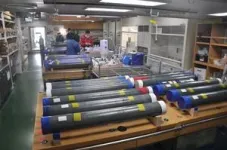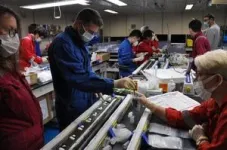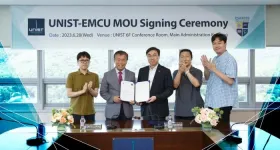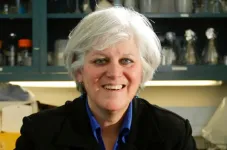(Press-News.org) The Japan Trench is located on the “Pacific Ring of Fire”, a region of special interest in earthquake and deep-water research. “It is here that oceanic plates bend, form ultra-deep-water trenches and move below overriding plates in so-called subduction zones, while accumulating long-term global plate tectonic strain”, says Dr. Ken Ikehara from National Institute of Advanced Industrial Science and Technology, Japan, and co-chief scientist of IODP Expedition 386. “This energy is released cataclysmically during so-called megathrust earthquakes, like it happened in 2011 during the devastating Tohoku-oki Earthquake”. Earthquake-related seafloor deformation and shaking can remobilize large amounts of sediments and fresh organic carbon that is subsequently transferred by gravity flows into the terminal sink of hadal trench basins. In order to study the long-term history of megathrust earthquakes and investigate the roles of earthquakes in the ultra-deep-water environment, the IODP Expedition 386 team has collected and analysed 58 sediment cores taken from holes cored up to 37.82 meters deep in the sea bed at 15 sites along the 500-km-long trench axis. “These operational expedition achievements of successful deep-subsurface sampling at water depths between 7445-8023 m below sea level set two new records in over 50 years of scientific ocean drilling and coring”, says Prof. Michael Strasser from the University of Innsbruck and co-chief scientist of the IODP Expedition 386. “We have cored the deepest water site at a water depth of 8023 meters and recovered the deepest sub-sea level sample from 8060.74 meters below sea level”.
Analyses of such unprecedented samples and research led by Prof. Rui Bao at Ocean University of China has found large amount of labile dissolved carbon stored in the sediment interstitial water. The dissolved carbon storage implies active organic carbon remineralization in the hadal trenches that is much greater than in other deep-water environments of the open ocean. Using advanced radiocarbon techniques, the team discovered aging and accumulation of the dissolved organic and inorganic carbon in the deep subsurface sediments. “These are exciting results, because these dissolved carbon fractions may have great impacts on the deep carbon cycle as they are buried still deeper into the trench sediments and the subduction zone”, said Mengfan Chu, PhD candidate at Ocean University of China, and lead-author of the study now published in Nature Communications.
Active microbial-mediated dissolved carbon cycling in the deep subsurface sediments
A comprehensive geochemistry investigation on the sediment interstitial water based on IODP Expedition 386 results supports the hypothesis. Huge storages of methane are found in sediments along the whole Japan Trench, together with other outstanding geochemical characteristics of the interstitial water. This points to intensive microbial methanogenesis in the hadal trenches and is interpreted as an enhancement effect of repeated large earthquakes along the subduction zone. Through increasing organic carbon fluxes and regulating the physical and chemical characteristics of the sediment deposits, earthquakes serve as a powerful modulator in the trench carbon cycle and the deep biosphere metabolisms in these extreme environments. “These discoveries provide strong evidence that the hadal trenches are not ‘tranquil’ deep-sea environments as previously considered. We’re excited to say that more discoveries about the hadal trench carbon cycle are bound to be made in the future.” says Prof. Rui Bao. “For instance, in our study we also report the occurrence of authigenic carbonates in the deep subsurface of Japan Trench sediments, which suggests active transformation of carbon between its different forms (sedimentary, dissolved, gaseous and mineral) and implies that hadal trench environments host dynamic carbon cycling, which link the Earth’s surface and its deeper interior along subduction zones, providing great opportunities for future studies.”
Further perspectives of research in the Japan Trench
The new discoveries of a dynamic carbon cycle in the Japan trench represent the first major scientific achievement resulting from the novel high temporal and high spatial resolution subsurface sampling and investigation of hadal oceanic trench achieved by Expedition 386 in the Japan Trench. Alongside this first scientific IODP-Expedition 386 related publication, the preliminary results of the entire expedition are now released by IODP. Along with the new perspectives and further potential to advance our understanding of deep-sea elemental cycles and their influence on hadal environments, samples and data from this expedition also reveal fascinating event records ranging back more than 24000 years. This enables now-ongoing research and new perspectives for the discussion on long-term recurrence and hazards of major megathrust earthquakes. Thirty-six scientists with expertise in different geoscience disciplines from Austria, Australia, China, Finland, France, Germany, India, Japan, UK, and the United States are now conducting further researches using the samples acquired by the advanced ocean drilling platform of IODP. More substantial scientific advances are expected to push the frontier of ultra-deep-water, subduction zone and earthquake researches.
The International Ocean Discovery Program (IODP) is a publicly-funded international marine research program supported by 21 countries, which explores Earth's history and dynamics as recorded in seafloor sediments and rocks. IODP Expedition 386 – Japan Trench Paleoseismology – was jointly implemented by the European Consortium for Ocean Research Drilling (ECORD) and the Institute for Marine-Earth Exploration and Engineering (MarE3) within the Japan Agency for Marine-Earth Science and Technology (JAMSTEC).
More Information:
About the expedition - https://www.ecord.org/expedition386
About the research program - https://www.iodp.org
About the European part of the IODP program - https://www.ecord.org
About the Japanese part of the IODP program - http://www.j-desc.org
END
Scientific ocean drilling discovers dynamic carbon cycling in the ultra-deep-water Japan Trench
2023-09-11
ELSE PRESS RELEASES FROM THIS DATE:
University of Houston researchers charting a sustainable course in oceanic carbon capture
2023-09-11
As researchers around the world race against time to develop new strategies and technologies to fight climate change, a team of scientists at the University of Houston is exploring one possible way to directly reduce the amount of carbon dioxide in the environment: Negative emissions technologies (NETs).
Mim Rahimi, assistant professor of environmental engineering at UH’s Cullen College of Engineering is leading the development of an emerging NET called electrochemical direct ocean capture (eDOC), which helps the ocean cleanse itself of harmful carbon dioxide. The concept ...
Antidepressants may reduce negative memories while improving overall memory, according to Rice study
2023-09-11
New research from Rice University finds that antidepressants may actually reduce negative memories in individuals suffering from depression while improving overall memory function.
The study, “Perceived antidepressant efficacy associated with reduced negative and enhanced neutral mnemonic discrimination,” appears in the latest edition of Frontiers in Human Neuroscience. It examines how antidepressant use in depressed individuals affects memories, both good and bad.
Stephanie Leal, an assistant professor of psychological sciences at Rice, is the study’s lead author. She said the study’s main finding about the link between antidepressants ...
Hybrid catalyst produces critical fertilizer and cleans wastewater
2023-09-11
Agriculture relies on synthetic nitrogen fertilizer, which is made using energy- and carbon-intensive processes and creates nitrate-containing runoff. Researchers have long sought solutions to reduce emissions from the industry that accounts for 3% of energy consumption each year.
A collaboration between two labs at Northwestern University, partnering with the University of Toronto, has found that producing the fertilizer urea using electrified synthesis could both denitrify wastewater while enabling low-carbon-intensity urea production. The process, which includes converting carbon ...
UNIST signs cooperation MoU with Eswatini Medical Christian University
2023-09-11
UNIST has taken a significant step towards combating women’s cancer on the African continent by signing an MOU with Eswatini Medical Christian University (EMCU) on June 28, 2023. The primary purpose of this partnership is to enhance cooperation in the diagnosis and treatment of cervical cancer, marking the beginning of a promising initiative.
Under this agreement, UNIST will lead research and development efforts in cervical cancer diagnosis and treatment technologies, while EMCU will provide a clinical test bed for these advancements.
The ...
OSE Immunotherapeutics announces: positive phase 3 data from its cancer vaccine in lung cancer patients with resistance to previous immunotherapy published in Annals of Oncology
2023-09-11
Nantes, France – September 11, 2023, 6:00pm CET – OSE Immunotherapeutics SA (ISIN: FR0012127173; Mnemo: OSE) today announced the peer-reviewed publication in Annals of Oncology* of the randomized Phase 3 clinical trial (Atalante-1) on T-cell epitope cancer vaccine Tedopi® in HLA-A2 positive patients with advanced or metastatic NSCLC in monotherapy in third line NSCLC with secondary resistance to immune checkpoint inhibitors (ICI).
Tedopi® is a novel T-cell epitope-based cancer vaccine targeting five tumor-associated antigens, ...
Chaplin receives funding for study integrating neural and momentary assessment of parenting, arousal and adolescent substance use
2023-09-11
Tara Chaplin, Associate Professor, Clinical Psychology, received $500,664 from the National Institutes of Health for an Independent Scientist Career Award titled: "Integrating neural and momentary assessment of parenting, arousal, and adolescent substance use."
This Independent Scientist K02 Award will provide Dr. Chaplin with cutting edge advanced training to enhance her career and transform her program of research. Through this training, Dr. Chaplin will integrate ecological momentary assessment (EMA) science into her expertise in developmental neuroscience to understand from a neural and momentary level parenting, emotion, and substance use associations ...
Smith receives funding for watershed programs
2023-09-11
Cynthia Smith, Associate Professor and K12 Education Director, Potomac Environmental Research and Education Center (PEREC), Environmental Science and Policy, received $60,750 from Fairfax County Public Schools for: "FCPS Watershed Programs." This funding began in July 2023 and will end in late June 2024. Since 2010, Smith has worked closely with the FCPS science office to deliver outdoor, hands-on field investigations to 5,200 seventh graders annually. Over 350 Mason students have worked as PEREC field interpreters, honing ...
Moran and Yao to study interpretability for neural language models of source code
2023-09-11
Kevin Moran, Assistant Professor, Computer Science, and Ziyu Yao, Assistant Professor, Computer Science, are set to receive funding from the National Science Foundation for: "Collaborative Research: SHF: Medium: Toward Understandability and Interpretability for Neural Language Models of Source Code."
Moran and Yao will develop a framework and methodology that enables researchers who build AI-powered developer tools and software engineers who use these tools to interpret why the underlying models make the predictions they do.
Their objective is to allow researchers to obtain detailed insights into why a model may not ...
How is ceviche ‘cooked?’ (video)
2023-09-11
WASHINGTON, Sept. 11, 2023 — What does it mean to have “cooked” something? Is heat the only way to break down proteins and transform raw ingredients? If you love ceviche, you know that’s not true … but how exactly does ceviche get “cooked?” No heat source is used, but it still undergoes a process in which proteins are denatured. We’re taking a closer look at proteins, how they denature and what that means for the food on your plate. https://youtu.be/Pw6apr3TBzY?si=RdIYP5j3B0daGtxw
Reactions ...
American Heart Association recognizes UK’s Cassis for excellence in hypertension research
2023-09-11
LEXINGTON, Ky. (Sept. 11, 2023) — The University of Kentucky’s Vice President for Research and leading cardiovascular scientist is being recognized for her foundational work in the field of hypertension with a prestigious award from the American Heart Association (AHA).
Lisa Cassis, Ph.D., a professor in the College of Medicine’s Department of Pharmacology and Nutritional Sciences, has been continuously funded by the National Institutes of Health (NIH) since joining the UK faculty in 1988.
Cassis has led many multimillion-dollar projects, including serving as program director of an $11.3 million NIH-supported Center of Biomedical Research ...






